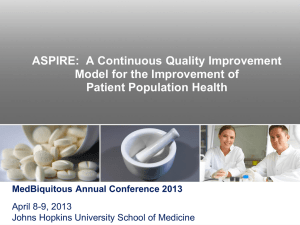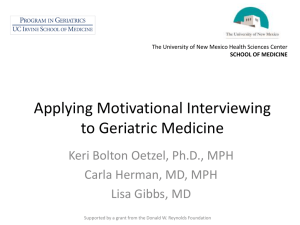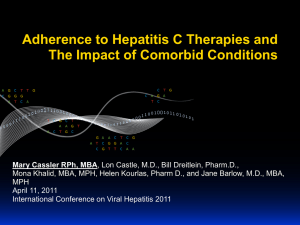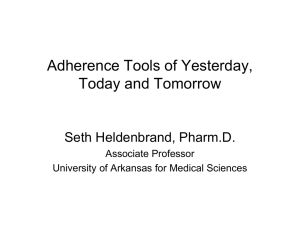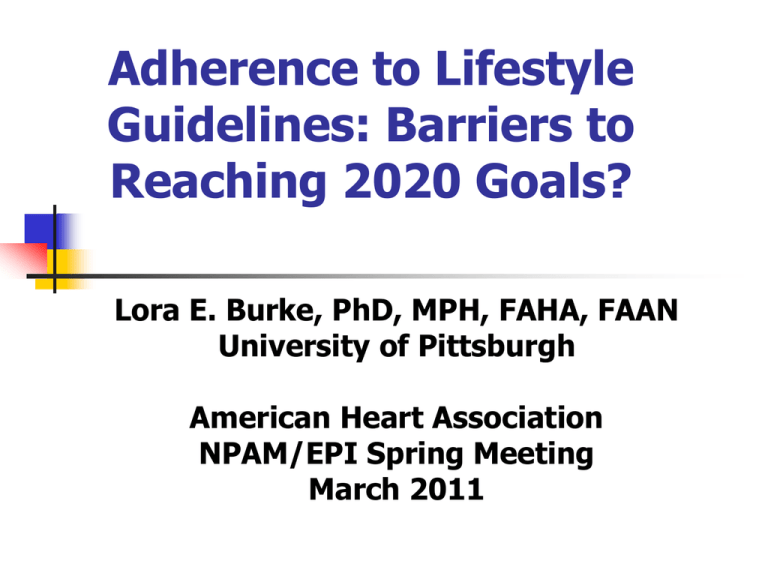
Adherence to Lifestyle
Guidelines: Barriers to
Reaching 2020 Goals?
Lora E. Burke, PhD, MPH, FAHA, FAAN
University of Pittsburgh
American Heart Association
NPAM/EPI Spring Meeting
March 2011
No Conflicts to Disclose
Research is supported by NIH
AHA 2020 IMPACT GOALS
“By 2020, to improve the
cardiovascular health of all
Americans by 20% while reducing
deaths from cardiovascular
diseases and stroke by 20%.”
Healthy Lifestyle
Healthy diet
energy balanced and nutrient dense
fruits and vegetables
high-fiber whole grains, low-fat milk, seafood
reduced added sugars, solid fats, refined
grains and sodium
Physical activity (PA)
150 min/wk of moderate (MPA)
75 min vigorous (VPA), or combination of two
Shifts in Food Environment
1970 – 2008
Average daily per capita
calories (+30%)
Added fats and oils (+56%)
Added sugars & sweeteners
(+15%)
1970
2008
2057 cal
2674 cal
56 lbs
87 lbs
119 lbs
136 lbs
Shifts in Food Environment
1970 – 2008
Total milk beverage declined 33%
Fruit juice increased 25%
Carbonated soft drinks increased 20%
Diet soft drinks increased 58%
Regular soft drinks increased 9%
Van Horn et al., 2010 Dietary Guidelines Advisory Committee
Dietary Intakes in Comparison to
Recommended Intake Levels/Limits
2010 Dietary Guidelines Advisory Committee Report
Full Adherence to Heart Healthy
Behaviors in US Sample
2000 BRFSS data
Examined those with & without CHD
Excluded those with poor physical health or
activity limitations
Defined fully adherent as:
Diet: ≥ 5 servings F & V/day
PA: MPA 5 days/wk for 30 min or VPA 3 days/wk
for 20 min
Smoking: Never or former smoker
Miller et al., Prev Chronic Dis, 2005
Percentage of Respondents
Adherent to Recommendations
Smoking Abstinence
(76%)
47%
Fruit &
Vegetable
Intake
(18%)
10%
Physical
Activity
(24%)
14%
5%
None
2%
1%
4%
Without Heart Disease
18%
Miller, et al. 2005
Percentage of Respondents
Adherent to Recommendations
Smoking Abstinence
(80%)
48%
Fruit &
Vegetable
Intake
(22%)
12%
Physical
Activity
(21%)
12%
7%
2%
<1%
With Heart Disease
None
2%
16%
Miller, et al. 2005
Full Adherence to Heart Healthy
Behaviors in US Sample cont.
Adherence rates similar to earlier BRFSS
reports in 1990, 1994, and 1996
1 in 20 adherent to all 3 behaviors
> high school education
highest income
Younger population:
better adherence to PA
lower adherence to diet and nonsmoking
Miller et al., Prev Chronic Dis, 2005
Compliance with PA Guidelines
for Americans, NHANES ‘05-06
Self-Report Data
Accelerometer Data
324.5±18.6 min/wk MPA
73.6±3.9 min/wk VPA
62% met guidelines
45.1±4.6 min/wk MPA
18.6±6.6 min/wk VPA
9.6% met guidelines
Tucker et al., Amer J Prev Med, 2011
Age-Adjusted Prevalence of Obesity in Adults
Ages 20–74 by Sex and NHANES Survey
Note: Obesity is defined as a BMI (body mass index) of 30.0 and higher.
Source: Health, United States, 2009; NCHS.
©2010, American Heart Association, www.heart.org.
Note: the next 4 slides reflect the success that we
achieve in weight loss through behavioral treatment and
lifestyle approaches; however, the second part of the
curve indicates the high rate of recidivism due to lack of
sustained adherence to a healthy lifestyle. The following
slide reflects adherence and how it declines over time,
depicting four different behaviors. This slope occurs
across several behavioral domains, from diet and
exercise to medication-taking behaviors.
Trajectory of Weight Loss and
Regain
Jakicic et al., Arch Int Med 168;1550-1559, 2008
Trajectory of Weight Loss and
Regain
Wadden et al. Gastroenterology Vol. 132, No. 6, 2007
Trajectory of Weight Loss and
Regain
Svetkey, et al., JAMA; 299(10): 1139-1148, 2008
Trajectory of Weight Loss and
Regain
Burke et al., 2011
Decline in Treatment
Adherence Over Time
PREFER Trial
Acharya, Elci, Sereika et al., 2009
Summary of Adherence to
Healthy Lifestyle
Adherence to healthy lifestyle guidelines
is far below what is needed to achieve
the 2020 goals
Adherence to any Tx strategy declines
over time, especially after reduced
contact
Recidivism and weight regain remain
significant problems in the Tx of excess
weight
Key Barriers to Adherence
to Healthy Lifestyle
Access to healthy foods, recreational
settings
Cost
Nutrition knowledge/behavioral skills to
implement healthy lifestyle
Time required to incorporate behavior
change
Motivation to change & maintain behavior
in a non-supportive environment
Future Directions
Address overweight & obesity as a chronic
disorder that needs ongoing management
Make BMI a vital sign
Discuss weight with patients
Use technology to:
reach a greater portion of the population
provide ongoing contact/reinforcement
Prevent weight gain!
Call to Action
Address lifestyle nonadherence at
multiple levels
Modify the environment
Make healthy lifestyle the “norm”
Translate study findings behavioral Tx
Implement evidence-based adherenceenhancing strategies into clinical and
public health practice
After assessing 74 studies published between
1997 and 2007, authors concluded that a
combination of approaches at the
patient, provider, and health-policy level
yields better results than any isolated
strategy.



